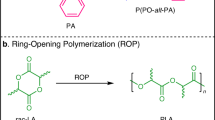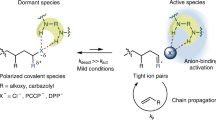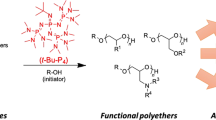Abstract
The tacticity of polymers is one of the governing microstructural parameters that determines their material properties. Current methods to access stereoregular polymers are based on coordination and ionic polymerizations. However, these polymerization methods are limited to a small group of monomers. By contrast, radical polymerization is compatible with diverse chemical functionalities but provides poor stereocontrol primarily due to the challenge of controlling the stereochemistry of carbon-centred radicals. Here, by covalently tethering a rare earth cation-based Lewis acid to cobalt(III) complexes, we designed a bimetallic catalytic system to achieve stereocontrol in living radical polymerization. The interplay of pendant group–Lewis acid interaction and cobalt-mediated reversible radical deactivation within a confined space results in chain propagation through a meso-configurated radical chain end. Acrylamide monomers with diverse polar and ionic pendant groups were polymerized in a stereoregular manner with a percentage of meso diads as high as 95%. Thermo-responsive, adhesion and electrical properties of homopolymers were readily diversified by tuning tacticity without compositional variance. This method provides a diversity-oriented design platform to access polymers with broadly tunable bulk, solution and interfacial properties from single monomer feedstock through tacticity engineering.

This is a preview of subscription content, access via your institution
Access options
Subscribe to this journal
Receive 12 digital issues and online access to articles
$119.00 per year
only $9.92 per issue
Buy this article
- Purchase on Springer Link
- Instant access to full article PDF
Prices may be subject to local taxes which are calculated during checkout




Similar content being viewed by others
Data availability
All data are available in the main text or the supplementary materials. Source data are provided with this paper.
References
Worch, J. C. et al. Stereochemical enhancement of polymer properties. Nat. Rev. Chem. 3, 514–535 (2019).
Karasz, F. E. & MacKnight, W. J. The influence of stereoregularity on the glass transition temperatures of vinyl polymers. Macromolecules 1, 537–540 (1968).
Pino, P. & Suter, U. W. Some aspects of stereoregulation in the stereospecific polymerization of vinyl monomers. Polymer 17, 977–995 (1976).
Uryu, T., Ohkawa, H. & Oshima, R. Synthesis and high hole mobility of isotactic poly(2-N-carbazolylethyl acrylate). Macromolecules 20, 712–716 (1987).
Wang, Y. et al. Facile synthesis of isotactic polyacrylonitrile via template polymerization in interlayer space for dielectric energy storage. ACS Appl. Polymer Mat. 2, 775–781 (2020).
Schurer, J. W., de Boer, A. & Challa, G. Influence of tacticity of poly(methyl methacrylate) on the compatibility with poly(vinyl chloride). Polymer 16, 201–204 (1975).
Rajalingam, P. & Radhakrishxan, G. Polyacrylonitrile precursor for carbon fibers. J. Macromol. Sci. C 31, 301–310 (1991).
Min, K. E. & Paul, D. R. Effect of tacticity on permeation properties of poly(methyl methacrylate). J. Polym. Sci., Part B: Polym. Phys. 26, 1021–1033 (1988).
Yan, M., Lo, J. C., Edwards, J. T. & Baran, P. S. Radicals: reactive intermediates with translational potential. J. Am. Chem. Soc. 138, 12692–12714 (2016).
Teator, A. J., Varner, T. P., Knutson, P. C., Sorensen, C. C. & Leibfarth, F. A. 100th Anniversary of macromolecular science viewpoint: the past, present, and future of stereocontrolled vinyl polymerization. ACS Macro Letters 9, 1638–1654 (2020).
Coates, G. W. Precise control of polyolefin stereochemistry using single-site metal catalysts. Chem. Rev. 100, 1223–1252 (2000).
Chen, E. Y. X. Coordination polymerization of polar vinyl monomers by single-site metal catalysts. Chem. Rev. 109, 5157–5214 (2009).
Neuwald, B., Caporaso, L., Cavallo, L. & Mecking, S. Concepts for stereoselective acrylate insertion. J. Am. Chem. Soc. 135, 1026–1036 (2013).
Ouchi, M., Kamigaito, M. & Sawamoto, M. Stereoregulation in cationic polymerization by designed Lewis acids. 1. Highly isotactic poly(isobutyl vinyl ether) with titanium-based Lewis acids. Macromolecules 32, 6407–6411 (1999).
Teator, A. J. & Leibfarth, F. A. Catalyst-controlled stereoselective cationic polymerization of vinyl ethers. Science 363, 1439 (2019).
Satoh, K. & Kamigaito, M. Stereospecific living radical polymerization: dual control of chain length and tacticity for precision polymer synthesis. Chem. Rev. 109, 5120–5156 (2009).
Braunecker, W. A. & Matyjaszewski, K. Controlled/living radical polymerization: features, developments, and perspectives. Prog. Polym. Sci. 32, 93–146 (2007).
Iizuka, Y. et al. Chiral (–)-DIOP ruthenium complexes for asymmetric radical addition and living radical polymerization reactions. Eur. J. Org. Chem. 2007, 782–791 (2007).
Puts, R. D. & Sogah, D. Y. Control of living free-radical polymerization by a new chiral nitroxide and implications for the polymerization mechanism. Macromolecules 29, 3323–3325 (1996).
Porter, N. A., Allen, T. R. & Breyer, R. A. Chiral auxiliary control of tacticity in free radical polymerization. J. Am. Chem. Soc. 114, 7676–7683 (1992).
Habaue, S. & Okamoto, Y. Stereocontrol in radical polymerization. Chem. Record 1, 46–52 (2001).
Paleos, C. M. Polymerization in Organized Media (CRC Press, 1992).
Isobe, Y., Fujioka, D., Habaue, S. & Okamoto, Y. Efficient Lewis acid-catalyzed stereocontrolled radical polymerization of acrylamides. J. Am. Chem. Soc. 123, 7180–7181 (2001).
Bovey, F. Polymer NSR spectroscopy. V. The effect of zinc chloride on the free radical polymerization of methyl methacrylate. J. Polym. Sci. 47, 480–481 (1960).
Noble, B. B. & Coote, M. L. in Advances in Physical Organic Chemistry Vol. 49 (eds Williams, I. H. & Williams, N. H.) 189–258 (Academic Press, 2015).
Zhao, Y., Yu, M. & Fu, X. Photo-cleavage of the cobalt–carbon bond: visible light-induced living radical polymerization mediated by organo-cobalt porphyrins. Chem. Commun. 49, 5186–5188 (2013).
Wayland, B. B., Poszmik, G., Mukerjee, S. L. & Fryd, M. Living radical polymerization of acrylates by organocobalt porphyrin complexes. J. Am. Chem. Soc. 116, 7943–7944 (1994).
Romain, C., Thevenon, A., Saini, P. K. & Williams, C. K. in Carbon Dioxide and Organometallics (ed. Lu, X.-B.) 101–141 (Springer, 2015).
Delferro, M. & Marks, T. J. Multinuclear olefin polymerization catalysts. Chem. Rev. 111, 2450–2485 (2011).
Wu, Z., Peng, C.-H. & Fu, X. Tacticity control approached by visible-light induced organocobalt-mediated radical polymerization: the synthesis of crystalline poly(N,N-dimethylacrylamide) with high isotacticity. Polym. Chem. 11, 4387–4395 (2020).
Imamura, Y., Fujita, T., Kobayashi, Y. & Yamago, S. Tacticity, molecular weight, and temporal control by lanthanide triflate-catalyzed stereoselective radical polymerization of acrylamides with an organotellurium chain transfer agent. Polym. Chem. 11, 7042–7049 (2020).
Shanmugam, S. & Boyer, C. Stereo-, temporal and chemical control through photoactivation of living radical polymerization: synthesis of block and gradient copolymers. J. Am. Chem. Soc. 137, 9988–9999 (2015).
Lutz, J.-F., Neugebauer, D. & Matyjaszewski, K. Stereoblock copolymers and tacticity control in controlled/living radical polymerization. J. Am. Chem. Soc. 125, 6986–6993 (2003).
Izatt, R. M., Pawlak, K., Bradshaw, J. S. & Bruening, R. L. Thermodynamic and kinetic data for macrocycle interaction with cations, anions, and neutral molecules. Chem. Rev. 95, 2529–2586 (1995).
Arnaud-Neu, F., Delgado, R. & Chaves, S. Critical evaluation of stability constants and thermodynamic functions of metal complexes of crown ethers (IUPAC Technical Report). Pure Appl. Chem. 75, 71–102 (2003).
Izatt, R. M. et al. Thermodynamic and kinetic data for cation-macrocycle interaction. Chem. Rev. 85, 271–339 (1985).
Isobe, Y., Nakano, T. & Okamoto, Y. Stereocontrol during the free‐radical polymerization of methacrylates with Lewis acids. J. Polym. Sci., Part A: Polym. Chem. 39, 1463–1471 (2001).
Park, B., Imamura, Y. & Yamago, S. Stereocontrolled radical polymerization of acrylamides by ligand-accelerated catalysis. Polym. J. 53, 515–521 (2021).
Ray, B. et al. RAFT polymerization of N-isopropylacrylamide in the absence and presence of Y(OTf)3: simultaneous control of molecular weight and tacticity. Macromolecules 37, 1702–1710 (2004).
Su, X. et al. Stereocontrol during photo-initiated controlled/living radical polymerization of acrylamide in the presence of Lewis acids. Eur. Polym. J. 44, 1849–1856 (2008).
Doi, Y. & Asakura, T. Catalytic regulation for isotactic orientation in propylene polymerization with Ziegler-Natta catalyst. Makromol. Chem. Phys. 176, 507–509 (1975).
Seliktar, D. Designing cell-compatible hydrogels for biomedical applications. Science 336, 1124–1128 (2012).
Zhao, Y. et al. Somatosensory actuator based on stretchable conductive photothermally responsive hydrogel. Sci. Robotics 6, eabd5483 (2021).
Liu, H. & Zhu, X. Lower critical solution temperatures of N-substituted acrylamide copolymers in aqueous solutions. Polymer 40, 6985–6990 (1999).
Ou, W. et al. In-situ cryo-immune engineering of tumor microenvironment with cold-responsive nanotechnology for cancer immunotherapy. Nat. Commun. 14, 392 (2023).
Pantula, A. et al. Untethered unidirectionally crawling gels driven by asymmetry in contact forces. Sci. Robotics 7, eadd2903 (2022).
Zhao, D., Wang, P., Zhao, Q., Chen, N. & Lu, X. Thermoresponsive copolymer-based draw solution for seawater desalination in a combined process of forward osmosis and membrane distillation. Desalination 348, 26–32 (2014).
Tsuchiizu, A., Hasegawa, T. & Katsumoto, Y. Water sorption on a thin film of stereocontrolled poly(N-ethylacrylamide) and poly(N,N-diethylacrylamide). In Proc. ICOMF14 – 14th International Conference on Organized Molecular Films (LB 14), MATEC Web of Conferences, 03001 (EDP Sciences, 2013).
Rzaev, Z. M. O., Dinçer, S. & Pişkin, E. Functional copolymers of N-isopropylacrylamide for bioengineering applications. Prog. Polym. Sci. 32, 534–595 (2007).
Pang, X. & Cui, S. Single-chain mechanics of poly(N,N-diethylacrylamide) and poly(N-isopropylacrylamide): comparative study reveals the effect of hydrogen bond donors. Langmuir 29, 12176–12182 (2013).
Katsumoto, Y., Kubosaki, N. & Miyata, T. Molecular approach to understand the tacticity effects on the hydrophilicity of poly(N-isopropylacrylamide): solubility of dimer model compounds in water. J. Phys. Chem. B 114, 13312–13318 (2010).
Wirthl, D. et al. Instant tough bonding of hydrogels for soft machines and electronics. Sci. Adv. 3, e1700053 (2017).
Li, J. et al. Tough adhesives for diverse wet surfaces. Science 357, 378–381 (2017).
Cui, C. & Liu, W. Recent advances in wet adhesives: adhesion mechanism, design principle and applications. Prog. Polym. Sci. 116, 101388 (2021).
Larcher, D. & Tarascon, J. M. Towards greener and more sustainable batteries for electrical energy storage. Nat. Chem. 7, 19–29 (2015).
Kim, H. J., Chen, B., Suo, Z. & Hayward, R. C. Ionoelastomer junctions between polymer networks of fixed anions and cations. Science 367, 773–776 (2020).
Gao, D. & Lee, P. S. Rectifying ionic current with ionoelastomers. Science 367, 735–736 (2020).
Lopez, J., Mackanic, D. G., Cui, Y. & Bao, Z. Designing polymers for advanced battery chemistries. Nat. Rev. Materials 4, 312–330 (2019).
Choi, U. H. et al. Ionic conduction and dielectric response of poly(imidazolium acrylate) ionomers. Macromolecules 45, 3974–3985 (2012).
Weiber, E. A. & Jannasch, P. Ion distribution in quaternary-ammonium-functionalized aromatic polymers: effects on the ionic clustering and conductivity of anion-exchange membranes. Chem. Sus. Chem. 7, 2621–2630 (2014).
Acknowledgements
This project was financially supported by United States National Science Foundation (grant no. CHE-2108681). M.Z. acknowledges the support through a 3M Non-Tenured Faculty Award. J.M. Mayer and E. Stewart-Jones are acknowledged for their assistance with the variable-temperature ultraviolet-visible light measurements. We thank P. Guo for light intensity measurement, J. Yan for providing access to a cold room to carry out low-temperature polymerizations, and A. Datye and Y. Xue for help with the thermomechanical tests. We acknowledge N. Hazari, S.J. Miller, S. Lin, K. Kawamoto, Y. Gu, J. Zhao, A.N. Le and Y. Ma for helpful discussions.
Author information
Authors and Affiliations
Contributions
M.Z., X.Z. and F.L. designed the research. X.Z., F.L. and M.C. conducted the experiments. M.Z., X.Z. and M.C. wrote the manuscript with input from F.L.
Corresponding author
Ethics declarations
Competing interests
X.Z. and M.Z. are inventors on a patent application (US provisional patent application no. 63/427,662) submitted by Yale University that covers the development of catalysts/initiators for stereocontrolled living polymerizations and of related tacticity-engineered functional polymers. The remaining authors declare no competing interests.
Peer review
Peer review information
Nature Synthesis thanks Shigeru Yamago and the other, anonymous, reviewer(s) for their contribution to the peer review of this work. Primary Handling Editor: Alison Stoddart, in collaboration with the Nature Synthesis team.
Additional information
Publisher’s note Springer Nature remains neutral with regard to jurisdictional claims in published maps and institutional affiliations.
Supplementary information
Supplementary Information
Materials and Methods, Text, Figs. 1–101 and Tables 1–22.
Source data
Source Data Fig. 2
Statistical source data.
Source Data Fig. 3
Statistical source data.
Source Data Fig. 4
Statistical source data.
Rights and permissions
Springer Nature or its licensor (e.g. a society or other partner) holds exclusive rights to this article under a publishing agreement with the author(s) or other rightsholder(s); author self-archiving of the accepted manuscript version of this article is solely governed by the terms of such publishing agreement and applicable law.
About this article
Cite this article
Zhang, X., Lin, F., Cao, M. et al. Rare earth–cobalt bimetallic catalysis mediates stereocontrolled living radical polymerization of acrylamides. Nat. Synth 2, 855–863 (2023). https://doi.org/10.1038/s44160-023-00311-9
Received:
Accepted:
Published:
Issue Date:
DOI: https://doi.org/10.1038/s44160-023-00311-9
This article is cited by
-
Porphyrins pave the way to precision polymers
Nature Synthesis (2023)



